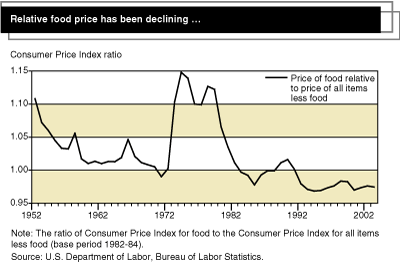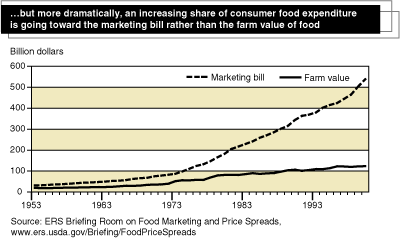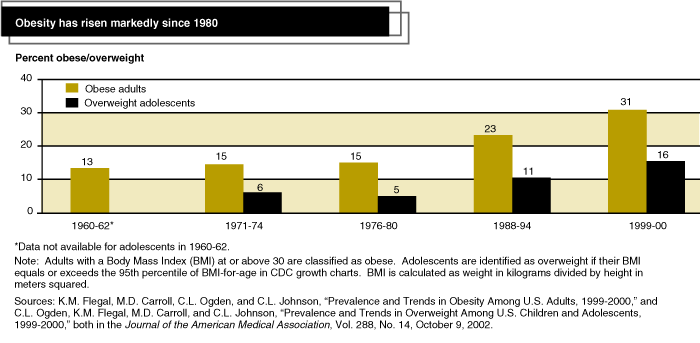The Price is Right: Economics and the Rise in Obesity
- by Jay Variyam
- 2/1/2005
In 2003, U.S. Surgeon General Richard Carmona said in testimony before the House of Representatives: 'I welcome this chance to talk with you about a health crisis affecting every State, every city, every community, and every school across our great Nation. The crisis is obesity. It's the fastest growing cause of death in America.'
In 1943, Metropolitan Life Insurance Company declared 'Overweight is so common that it constitutes a national health problem of the first order.'
One thing is clear: The obesity problem didn't occur overnight. In fact, it has been emerging for decades but only recently has it reached crisis proportions and grabbed national headlines. While Americans at the turn of the 20th century may have aspired to be plump, by now most people are aware of the health problems associated with excess weight. Diet books top the bestseller list, the electronic and print media overwhelm us with nutrition do's and don'ts, but progress is slow or even nonexistent. The reality is that we eat too much and move too little.
Americans are indeed among the heaviest people on earth. Not only are we getting fatter, but we're doing it at a younger age. How we got to this point is a complex story with genetic, physiologic, psychologic, sociologic, and economic subplots. Here, we look at the economic plot line. But be forewarned. Economics does not provide all the answers. Even so, examining the past under an economist's lens may help us unearth and evaluate potential solutions.
Technological Advances Have Lowered the Price of Food . . .
Our story hinges on prices and income. When the price of something preferred falls, people acquire more of it by giving up things that have remained firm or risen in price. Conversely, when the price of something goes up, money is reallocated from it to alternatives. And when incomes rise, things that were formerly unaffordable—be it a second car or a second helping—are suddenly attainable.
While the money required to buy a product (market price) is usually the major component of price, its 'full' price includes other costs like time costs and information costs. For example, the full price of a home-prepared meal includes the cost of ingredients bought at the store, travel costs to the store and back, the cost of time spent preparing the food, and information costs related to nutrition knowledge and cooking techniques. A change in any component of the price will change the incentive for consuming that product, as well as its closely related alternatives.
Prices change over time due to a variety of reasons, including availability of resources, but the prime mover of prices is technology. Better production and distribution technologies generate more and better goods, driving prices down. The market for computers in the past 20 years exemplifies this phenomenon.
Food prices, whether at the store or at a restaurant, have been declining relative to prices of all other items. Between 1952 and 2003, the ratio of food prices to the price of all other goods has fallen by 12 percent. But the drop is more dramatic if we factor in 'quality' improvements—the reduced time cost of acquiring and preparing food (convenience), greater variety, and omnipresent restaurants and vending machines. Foods that once were available only seasonally are now available year-round. Advances in food processing and packaging have introduced a multitude of ready-to-eat foods, available virtually anywhere and at any time.
Harvard University's David Cutler, Edward Glaser, and Jesse Shapiro have suggested that the increase in food consumption prompted by the falling time cost of food is the major cause behind the surge in obesity since 1980. They note: 'Technological innovations—including vacuum packing, improved preservatives, deep freezing, artificial flavors, and microwaves—have enabled food manufacturers to cook food centrally and ship it to consumers for rapid consumption. In 1965, a married woman who didn't work spent over two hours per day cooking and cleaning up from meals. In 1995, the same tasks took less than half the time.'
Although greater convenience, growing portion sizes, and increased accessibility of restaurant meals have been blamed for contributing to the rise in obesity, in economic terms, these are quality attributes that are valued by consumers. As a matter of fact, an increasing share of our food dollars are going toward such value-added attributes rather than the food itself. ERS's marketing bill data show that, between 1953 and 2000, the share of total consumer food expenditures that pays for such marketing components has gone up from 63 percent to 81 percent, with the bulk of this growth occurring since 1980.
. . . and Raised the Price of Physical Activity
Technology-driven changes in the price of physical activity and price of leisure activities have greatly altered the incentives for energy expenditure. The full price of physical activity is the opportunity cost of allotted time—the value of the most preferable alternative given up by allotting time for a walk in the neighborhood or a run in the park. For some, there is the additional cost of joining a gym or health club or the cost of information from subscribing to a health or fitness magazine.
As health economists Darius Lakdawalla and Tomas Philipson have noted, in earlier agricultural and industrial times, the opportunity cost of physical activity was virtually zero. Energy expenditure came with one's work, which was strenuous—essentially, people were paid to exercise. With increased mechanization and the shift of jobs into service industries, the opportunity cost of physical activity began to rise. In today's post-industrial society, physical labor is rarer and people must pay to—and budget time for—exercise.
As with jobs, technological changes have reduced the amount of physical activity required for a host of other daily activities, from routine household work to transportation. We no longer use a push mower to cut our grass or carry laundry back and forth from the clothesline in the backyard. These forgone energy expenditures now have to come from voluntary physical activity involving the conscious allocation of time, effort, and sometimes money, as when people join a gym or sports club.
Although job-related changes in physical activity may partly explain the longrun trend in weight gain, they cannot account for the post-1980 surge in obesity, especially since this uptrend has affected children as well. One trend that has sapped physical activity from all age groups in the last few decades is technological advances in the entertainment and electronics sectors. The supply and variety of passive entertainment options—from cable TV to video games, DVDs, and the Internet—has exploded. Since time is finite, this creates an incentive to forgo physical activity for more plentiful passive entertainment. The net effect of technological advances in the work place, at home, in transportation, and in leisure-time choices is a reduction in daily energy expenditure, leaving individuals with a stark choice: whether or not to fill the gap through voluntary physical activity.
Rising Incomes Reinforce Price Effects
At subsistence income levels, people spend most of their income on food and choice is determined mainly by price and availability. As incomes grow, preferences exert a greater role—people buy less coarse grains, cereals, and potatoes, for example, and buy more meats and prepared foods. Demand rises for foods that supply additional quality attributes beyond basic nutrients, such as tastiness, convenience, and ease of preparation.
Nowhere is this effect of rising incomes more visible than Americans' habit of dining out. As income increases, people tend to spend a greater share of additional income on dining out than on foods prepared at home. ERS studies show a 10-percent increase in income leads to a 4.6-percent increase in a household's away-from-home food expenditures compared with a 1.3-percent increase in at-home food expenditures. With the foodservice industry offering more choices—from fast food to a growing array of ethnic restaurants—the share of total food expenditure that Americans spend on dining out has risen from 28 percent in 1962 to 47 percent in 2003.
Other ERS research shows that, ounce for ounce, foods eaten away from home are more calorie-dense than foods prepared at home, and thus could be a factor in the obesity surge. Health economists Shin-Yi Chou, Michael Grossman, and Henry Saffer have linked higher restaurant density with greater obesity rates over time and across geographical areas. But the growing demand for dining out suggests that our preference for convenience, time savings, and variety is outweighing concerns about obesity.
The technological changes driving modern economic growth have raised household incomes, reduced the price of food, and increased the price of physical activity. The resulting increase in energy consumption and flattening of energy expenditure has tilted the weight equation in favor of a steady weight gain across all segments of U.S. society.
Is There a Role for Government Intervention?
Changing economic incentives have contributed to the rise in obesity in the U.S. For the tide of obesity to reverse, therefore, the incentives to eat healthfully and be physically active have to change. One way to achieve this is through government intervention, including taxes and/or subsidies. For example, a tax on fatty foods can increase the price of calories and thus decrease energy consumption. A tax break promoting employer subsidies for health club memberships can reduce the price of physical activity and thus increase energy expenditure.
Should the government alter incentives so as to reduce obesity? In general, government intervention is economically justified when the costs of someone's actions are borne by others (social costs or externalities), as in the case of industrial pollution, drunk driving, or secondhand smoke. Economists do not take the private costs of behaviors—that is, costs borne by the individuals themselves—into account when determining whether government intervention is justified. While there is some evidence to suggest that not all costs of obesity are private and that obesity-related costs are burdening Medicare and Medicaid, the jury is still out on the magnitude of these costs and whether they justify government intervention.
Still, the magnitude of improvements in private health and productivity from reducing obesity may be enough to justify government action, in the public health view. Disparities in obesity across income and racial/ethnic groups—low-income and Black/Hispanic groups are disproportionately obese—may justify government intervention on social equity grounds.
Although economics can help explain the rise in obesity and evaluate potential interventions, it is largely silent on why people have the preferences they do. Economists take preferences as they exist and then predict how outcomes or choices change as prices and incomes—or more generally, incentives—change. Other disciplines, however, study how preferences are formed and shaped. Biological research, for example, suggests that strong tastes for fat, sugar, and salt in foods are hard-wired into humans. Psychological research has questioned whether people have the sophisticated decisionmaking powers—accurately weighing future costs of current choices, for example—that economic models typically assume.
Economists are increasingly recognizing that such biological and psychological factors may prevent some people from making decisions in their long-term best interests. If obesity-related choices are influenced by such factors, interventions to reduce obesity that do not pass the conventional economic tests may be justified. The challenge would be to devise cost-effective policies that help people make decisions in their best interests without punishing those that are content with their choices.
Several studies are underway at ERS to help evaluate specific policies meant to address obesity. For example, a recent study suggests that taxing snack foods such as potato chips and cheese puffs—one of the interventions suggested by public health advocates—will have only a small impact on the amount of snacks consumed, and thus on caloric intake. The economic effects of such a tax and other public interventions to reduce obesity will be explored in greater detail in a forthcoming Amber Waves article.
This article is drawn from:
- Philipson, T., Dai, C., Helmchen, L. & Variyam, J. (2004). The Economics of Obesity: A Report on the Workshop Held at USDA's Economic Research Service. U.S. Department of Agriculture, Economic Research Service. EFAN-04004.
- Role of Food Prepared Away from Home in the American Diet, 1977-78 versus 1994-96: Changes and Consequences. (2002). Journal of Nutrition Education and Behavior. Vol. 34, pp.140-150..
- Societal Costs of Obesity: How Can We Assess When Federal Interventions Will Pay?. (2002). USDA/ERS. in FoodReview, Vol. 25, Issue 3..




